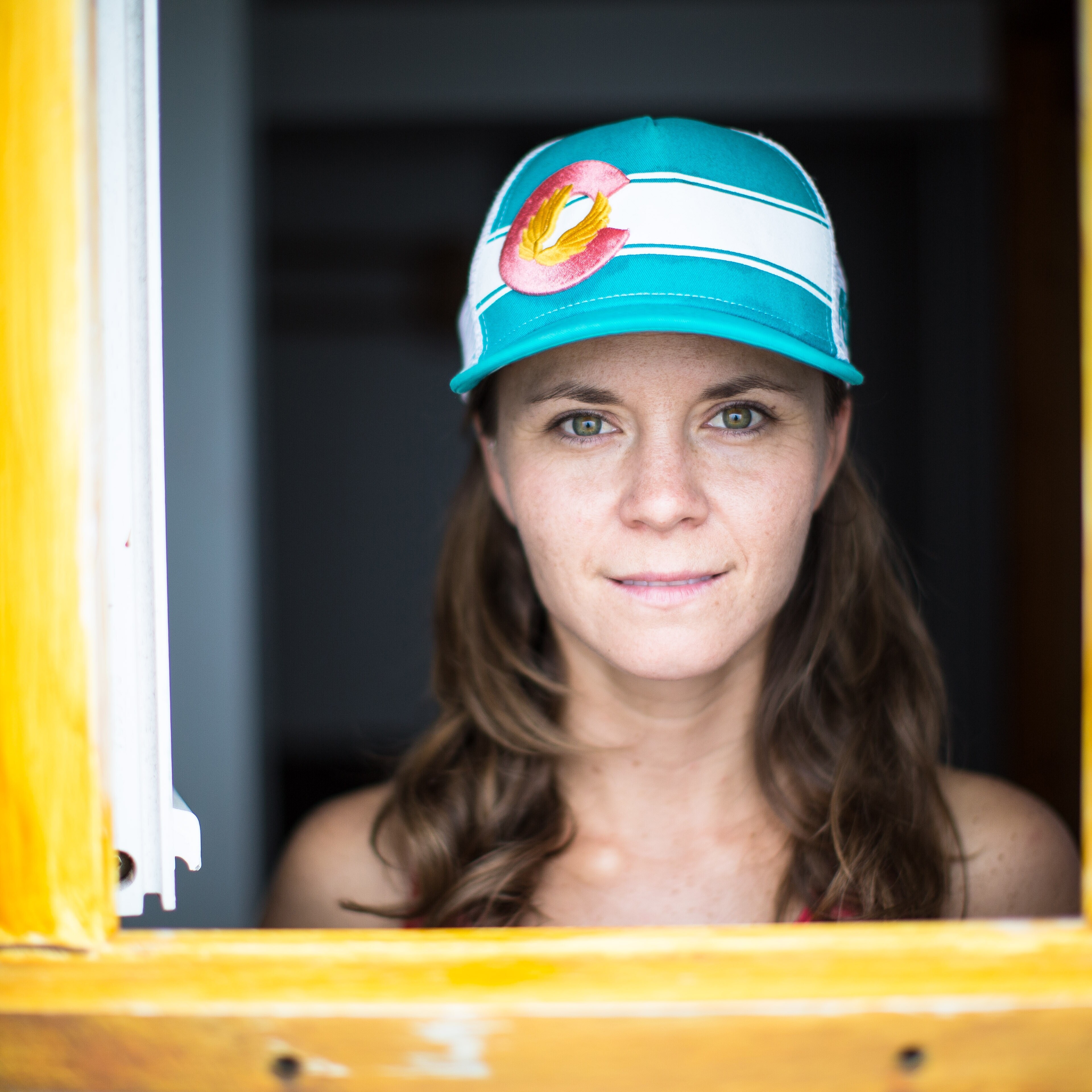Sleeping under the stars can be a lot of fun—as long as you have a good sleeping pad. A sleeping pad provides cushion and insulation, keeping you comfortable off the (literally) cold, hard ground. The right outdoor mattress should cushion your joints, keep you warmer throughout the night and pair nicely with your sleeping bag.
Sure, a sleeping pad might add a bit of luxury to your outing, but that doesn’t mean you have to lose a night’s sleep over the price. For starters, knowing what you need (versus what you want) can help you choose a lower-cost pad that still checks the necessary boxes. For example, if you’re car camping and pack weight isn’t an issue, you don’t have to look at pricier ultralight gear. If you typically camp in the warmer months, you can search for a pad with a lower R-value. Not sure where to start? Jump down to Buying Advice to learn more.
Thankfully, budget sleeping pads improve every year, and this year's crop proves you can enjoy a night's rest at a sliver of the price. To help you chose which one is right for you, we sent out a cohort of REI Co-op Member testers with the best sleeping pads that roughly $100 can buy at the co-op. We counted up their zzzs to learn which pads were the best for gram counters, comfort-seekers, car campers and more.
Read on to find the ideal, around-$100 sleeping pad for you.
Want to create a sleep system? Read The Best Budget Sleeping Bags: Tested to find a match for your pad.
Test Results
Find our quick recommendations here or read on for in-depth reviews.
- Best Budget Sleeping Pad for Car Camping REI Co-op Trailmade Self-Inflating Sleeping Pad
- Best Budget Sleeping Pad for Comfy Backpacking Big Agnes Divide Insulated Sleeping Pad
- Best Budget Sleeping Pad for Fast-and-Light Backpacking Sea to Summit Camp Self-Inflating Sleeping Pad
- Most Versatile Budget Sleeping Pad NEMO Switchback Sleeping Pad
- Best Budget Foam Pad Exped FlexMat Sleeping Pad
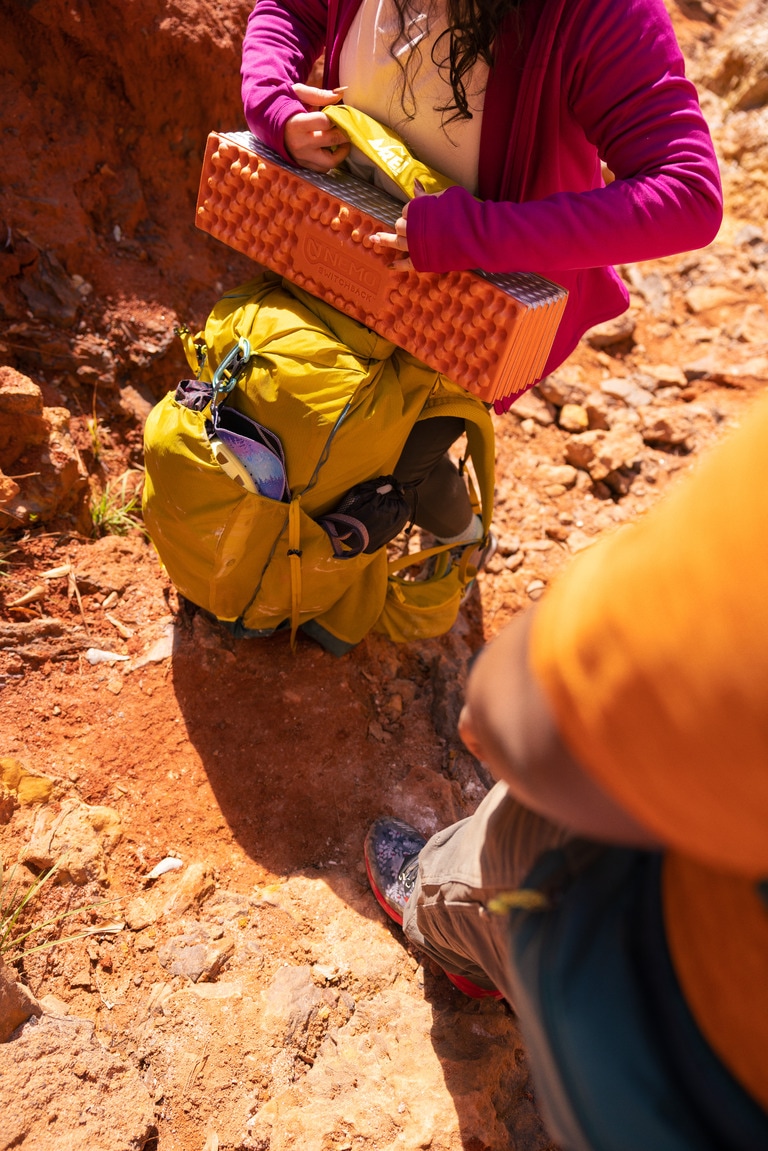
Best Budget Sleeping Pad for Car Camping & Editor’s Choice Award Winner
REI Co-op Trailmade Self-Inflating Sleeping Pad
Score 97
Versions Short, regular, regular wide, long wide
Pad type Self-inflating
R-value 5.5
Packed size 6.7 x 22.4 inches (short), 7 x 22.4 inches (regular), 7 x 26.9 inches (regular wide), 7 x 26.9 inches (long wide)
Pad thickness 1.5 inches
Weight 2 lbs. 4 oz. (short), 2 lbs. 7 oz. (regular), 3 lbs. (regular wide), 3 lbs. 4 oz. (long wide)
Good thing the Trailmade Self-Inflating Sleeping Pad from REI Co-op is so affordable, because as soon as your tentmates get a load of your blissful night’s sleep, they’ll want one of their own. (Our Illinois tester went the generous route instead: “Will be ordering one for my husband,” they said after one solo car-camping trip.)
While the 1.5-inch pad thickness might seem spare on paper, at the campground you’ll feel like you hit paydirt: The plush sleeping surface elevates your joints above rough terrain, while open-cell foam insulation brings the cozy comfort even in more extreme temps. While back-sleeping testers reported “exceptional” comfort, another said that rolling onto her side left her self-described bony hips feeling less supported. However, she said the insulation value makes up for the lack of cushion: “A 5.5 R-value is hard to come by at this price. You would typically have to pay 3x as much for that warmth value.” The pad’s durable bottom layer, comprising recycled polyester, resists wear and tear on twigs, ice shards or sharp stones. All of our testers found this pad to be an ideal car-camping companion, but likely wouldn’t tote it along for a backpacking trip due to its longer packed size and 2-plus-pounds heft.
One of the best features of the Trailmade self-inflating pad is that it doesn’t whisper all night like your kids might: It scored perfect marks for noiselessness. “Unlike air pads, it wasn’t noisy like a potato chip bag.” Buy here.
Bottom Line: Be as snug as a bug camping out of your VW Bug with the ultrawarm, moderately plush and utterly noiseless REI Co-op Trailmade Self-Inflating Sleeping Pad.
Testing Stats:
- Nights out: 7
- Testing states: Illinois, Oregon, Washington
- Best testing story: One tester found themselves at a very rocky dispersed campsite by a creek, and they were worried that the lumps, bumps and jagged edges would keep them awake. No need to worry: They slept. “This pad impressed the socks off me.” (Good thing they didn’t need socks, thanks to the Trailmade pad’s high R-value.)
Best Budget Sleeping Pad for Comfy Backpacking
Big Agnes Divide Insulated Sleeping Pad
Score 94
Versions Petite, regular, regular wide, long wide, double
Pad type Air
R-value 4
Packed size 4 x 7.5 inches (petite), 5 x 8 inches (regular), 5.5 x 8 inches (regular wide), 5.5 x 9 inches (long wide), 6.5 x 15 inches (double)
Pad thickness 3.5 inches
Weight 1 lb. 6 oz. (petite), 1 lb. 7 oz. (regular), 1 lb. 14 oz. (regular wide), 2 lbs. 1 oz. (long wide), 3 lbs. 12 oz. (double)
"My pad is comfier than your pad," declared one tester of the Divide Insulated from Big Agnes. Those are backcountry fighting words, but this 3.25-inch-thick mattress backed up the claim, tallying a perfect score in the comfort department in our head-to-head test. But this pad's ability to lift your weary joints more than 3 inches off the ground is only part of the story.
The most affordable sleeping pad in the Big Agnes lineup, the Divide Insulated boasts an R-value of 4, making it warm enough for three-season use when paired with the right bag. Big Agnes achieves this relatively high warmth rating with lightweight polyester insulation that works in conjunction with a reflective foil that traps heat and sends it back to your body like an emergency blanket. Our testers also praised the guardrails on the Insulated Air Core Ultra: The chambers are one-quarter inch thicker on the outside (3.5 inches total) than in the middle, which helps the sleeper stay centered on the pad.
The Divide Insulated is an air pad, which means that it's louder than other mattresses in this lineup. ("I sounded like I was snoozing on a pile of crumpled newspapers," our Montana tester reports.) Though aviation-grade TPU lamination ups the sturdiness factor, air mattresses are generally more susceptible to pops and leaks, so always travel with a patch kit. Our sample held its own against sticks and brambles in Glacier National Park, but we wouldn't make cowboy camping a habit. Buy here.
Bottom Line: The Big Agnes Divide Insulated Sleeping Pad provides unparalleled comfort for the price, making it a great option for backpackers willing to heft a bit more for a better night's sleep.
Testing Stats:
- Nights out: 19
- Testing states: Colorado, Montana
- Best testing story: One member's advice: Position your tent door toward the best view because you'll want to linger in bed after spending the night on the Divide Insulated Air Core Ultra. "I woke up in an alpine meadow and took my coffee right there, staring down Mount Sneffels from my sleeping bag," he says of Colorado's photogenic 14er.
Best Budget Sleeping Pad for Fast-and-Light Backpacking
Sea to Summit Camp Self-Inflating Sleeping Pad
Score 86
Versions Regular
Pad type Self-inflating
R-value 4.2
Packed size 6.5 x 10 inches
Pad thickness 1.5 inches
Weight 1 lb. 9 oz.
If there’s one thing backpackers love, it’s a blink-and-it’s-inflated sleeping pad that’s ready for bedtime in less time than it takes to eat two PB&Js. The Camp Self-Inflating Sleeping Pad from Sea to Summit goes from flat to full in mere moments, and its one-way inflation valve prevents air from leaking out even if you lean or lay on it. When you’re ready to roll (or at least roll the mat up), reverse the valve to keep air from drawing back in as you flatten the pad.
High packability is thanks to Sea to Summit's Delta Core technology, or triangular-shaped cut-outs in the core of the pad that reduce weight and bulk without compromising heat retention. While this pad might not be the pick for gram-counters, our testers were happy to tote it along for a little extra cushion on a backpacking trip. “Compresses nice and small,” says one tester who is an avid camper and backpacker and shared that it’s “one of the most comfortable of the smaller packed-up pads.” (The regular version is about the size of a Nalgene bottle.) Another tester said they’d happily backpack with it: “Having used foam and inflatable sleeping pads before, this was the most comfortable one that I've used. I’ve carried heavier!” One tester was grateful to use it as a kneeling pad quite a bit while getting themselves situated in their tent.
While the 75D polyester shell is durable against abrasion, it might be just a bit too “buoyant” for one tester, who was dumped from it like a capsizing ship. “On the one hand, the padding was extremely comfortable, when I was able to stay on it. On the other hand, rolling off it all night long means I woke up a lot.” A different tester solved this problem by going sleeping-bagless on the warmest nights, which was made easier by the pad’s toasty 4.2 R-value. An included pillow lock system (adhesive patches, included with the pad, that stick your headrest to your pad) make sure your head stays aloft. Buy here.
Bottom Line: The surprisingly packable Sea to Summit Camp Self-Inflating Sleeping Pad literally elevates a backpacking overnight in moments—it fills up quick and comfy, so you can rest your weary head (and back, and calves) in no time.
Testing Stats:
- Nights out: 9
- Testing states: Minnesota
- Best testing story: One tester was on a forced camping trip in the backyard after their partner had a COVID-19 exposure at work. “This meant that the tent (and everything in it) became my office, dining room and bedroom all in one. After work one day, I put down my computer, pulled out the book I was reading and laid down to take a break and transition out of the workday. If I let my mind drift just a little, I could half believe I was actually relaxing somewhere far from home.”
Most Versatile Budget Sleeping Pad
NEMO Switchback Sleeping Pad
Score 91
Versions Short, regular
Pad type Foam
R-value 2
Packed size 20 x 5 x 4 inches (short), 20 x 5.5 x 5 inches (regular)
Pad thickness 0.9 inches
Weight 10.5 ounces (short), 14.5 ounces (regular)
It's no surprise that a closed-cell foam pad was the lightest, most durable and most affordable in our test. What is surprising is that this particular one—the Switchback from NEMO—is comfortable to boot. It's almost an inch thick (20% thicker than its competitors) with squishy nodes that cushion joints and muscles. One tester dubbed it plush enough for back or stomach sleeping, "and when folded back on itself, it's the comfiest sit pad I've ever used," she says.
And the comfort doesn't come with a size penalty. When folded, the Switchback's nodes nest together, so it packs down just as small as thinner closed-cell foam pads, making it a good option for backpacking. "I used this on a fast-and-light desert mission, and I barely noticed I was carrying it," said one tester after a week-long trip through Utah's San Rafael Swell. (Note: An inch of cushion likely isn't enough to support your hips on hard ground if you're a side sleeper. And, as one tester noted, this isn’t our pick for most other camping. Despite its paper-thinness, the Switchback was a great barrier against cold and damp misery: One of our Minnesota testers woke up to the sounds of a massive late-spring downpour, and though the bottom of their tent was drenched, their Switchback was an island oasis.
The versatility of a closed-cell foam pad like the Switchback belies its categorization on REI.com. Our testers used the Switchback as an ultralight backpacking pad, a durable car-camping pad and a sit pad (you can't puncture a foam pad). They layered it on another mattress to double the warmth rating, accordioned it on its side to create a windbreak for their stoves and laid it on the beach in lieu of a towel. That's good bang for your buck. Buy here.
Bottom Line: The NEMO Switchback Sleeping Pad scores the hat trick of backpacking by being practically weightless, efficiently packable and almost unbelievably affordable.
Testing Stats:
- Nights out: 19
- Testing states: Colorado, Minnesota, Utah
- Best testing story: “Because it was so humid overnight because of the rain, I found I'd wriggled completely out of my sleeping bag in the middle of the night and was just sleeping on the pad. Who knows how long I was like that, but I must have been comfortable enough because it certainly didn't wake me up! (My dog did, however, when she tried to nose me off so she could have the pad to herself.)”
Best Budget Foam Sleeping Pad

Exped FlexMat Sleeping Pad
Score 91
Versions Medium, long wide
Pad type Closed-cell foam
R-value 1.5
Packed size 6 x 20.5 x 5 inches (medium), 5.5 x 25.6 x 5.3 inches (long wide)
Pad thickness 0.7 inches
Weight 12.3 ounces (medium), 1 lb. 0.8 oz (long wide)
Unfold comfort in a snap with the FlexMat Sleeping Pad from Exped, a featherweight but supportive closed-cell foam pad that’s a backpacker’s dream come true. Hardy microcellular IXPE foam can stand up to almost anything you might lay it down on, from packed dirt to rocky soil to “wet, uneven snow” as one tester experienced in Washington’s North Cascades. Its air-trapping egg-carton-style cell design locks in warmth and fits snuggly together when you accordion-pack the mat during waking hours.
A moderate R-value of 1.5 means this pad is mostly designed for cool-not-cold nights. When paired with another pad, it can also serve as an extra layer of insulation (without adding much weight or expense) when paired with another pad on extra chilly evenings.
Wondering whether a mattress barely thicker than half an inch could truly be comfortable? Don’t just take our word for it: Our Idaho tester reports, “Sleeping during pregnancy has been a major challenge, but I had no problems with this sleeping pad. It provided the perfect amount of support for my back.” (You heard it here first: Could the FlexMat be the best one-person pad that comfortably sleeps two?) Buy here.
Bottom Line: If you want a sleeping mat that’s barely there in your pack but makes all the difference under your sleeping bag, you can’t beat the feather-light but surprisingly squish Exped FlexMat Sleeping Pad.
Testing Stats:
- Nights out: 6
- Testing states: Idaho, Washington
- Best testing story: Our Washington tester encountered overnight temps as low as 35°F at their dispersed campground near Kangaroo Ridge in the North Cascades. The scene there has been described as “almost lunar-like”: The highest point on the ridge, known as Big Kangaroo, reaches an elevation of more than 8,200 feet.
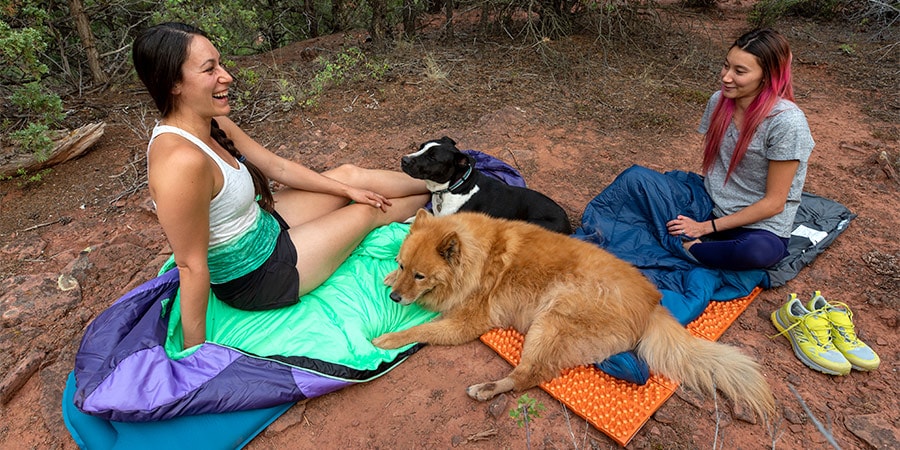
Buying Advice
When shopping for a backpacking sleeping pad, you're juggling the big three: low weight, adequate warmth and, well, padding. While specs tell the tale for weight and warmth, cushiness is more subjective.
Size affects weight, of course, and, if you're looking at an extra-wide and/or long pad, you should double check the dimensions of your tent to make sure it fits comfortably inside. If you're looking for a car-camping sleeping pad, your motorized packhorse is doing the heavy lifting, so just pick the warmest, cushiest pad you can afford. (After taking into account storage space both at home and in your vehicle.)
Any backpacking pad can also be used for car camping. If you want one pad for both activities, then choose it based on its backpacking attributes because car-camping pads are simply too bulky and heavy for backcountry use.
Types of Sleeping Pads
You have three main sleeping-pad styles to choose from.
Air pads: These inflatable mattresses are comfortable, pack down small and weigh very little. All quality air pads have some form of insulation inside, ranging from down to synthetics like PrimaLoft® to sophisticated arrays of reflective paneling. Air inflation is both a virtue and a drawback, however, allowing you to fine-tune pad firmness, but also making them subject to softening as temps drop. You also have to take care to ensure nothing punctures your pad. Field repairs are possible if you carry a patch kit. For tips on fixing both air pads and self-inflating pads, read How to Repair a Sleeping Pad.
Air pads are prone to making loud, crinkly sounds when you move around, which some people—and their tent mates—find annoying. Brands have engineered less rustly versions, but other pads will still be the quieter choice.
The only air pad in this guide is the Big Agnes Divide Insulated.
Self-inflating foam pads: These have open-cell foam insulation for warmth and padding, plus air inflation to enhance cushioning. To inflate one, you open a valve to let the outside air pressure plump up the pad. To get it fully inflated to your liking, though, you'll have to blow a lungful of air or two into it.
Self-inflating pads' warmth comes from the open-cell foam inside. Compared to air pads, they are heavier and bulkier to pack (you likely must strap it on the outside of your pack), but they're also more affordable. Because they're inflated, take care not to puncture them—and carry a field-repair patch kit on your trips.
There are two self-inflating sleeping pads on the list: the REI Co-op Trailmade and Sea to Summit Camp.
Closed-cell foam pads: The original backpacking pads, closed-cell foam mattresses still have devotees who revere them for their low prices—compared to other pads—and durability. (They can also be paired with another pad to boost overall warmth.) Constructed with air-cell-filled foam, these pads provide minimal warmth and minimal padding, but do so with minimal weight. Closed-cell foam pads fold or roll up for packing, forming bulky shapes that often must be strapped onto the outside of your pack. Many backpackers cut closed-cell foam pads down to a smaller size in order to ruthlessly slash weight or to create a sit pad.
Our foam pad representatives in this guide are the NEMO Switchback and Exped FlexMat.
Pad R-Values
R-value measures a pad's resistance to heat flowing through it (hence the "R"). Higher R-values are warmer. Below are rough guidelines about temperature conditions for different R-value ranges:
R-value | Conditions | Sleeping Pads |
< 2 | Warm weather | |
2–3.9 | Cool weather | |
4–5.4 | Cold weather | |
5.5+ | Extreme cold weather |
Sleep Systems
One big factor in warmth level is the sleeping bag you pair with your sleeping pad. This combo is your sleep system, which gives a more accurate picture of how warm you'll sleep.
If you use a less-insulated pad at colder temps, your sleeping bag might not live up to its temperature rating. To learn more about pad warmth ratings and get a look at how bags and pads work in tandem to keep you toasty, read the Sleep System section of How to Choose Sleeping Pads.
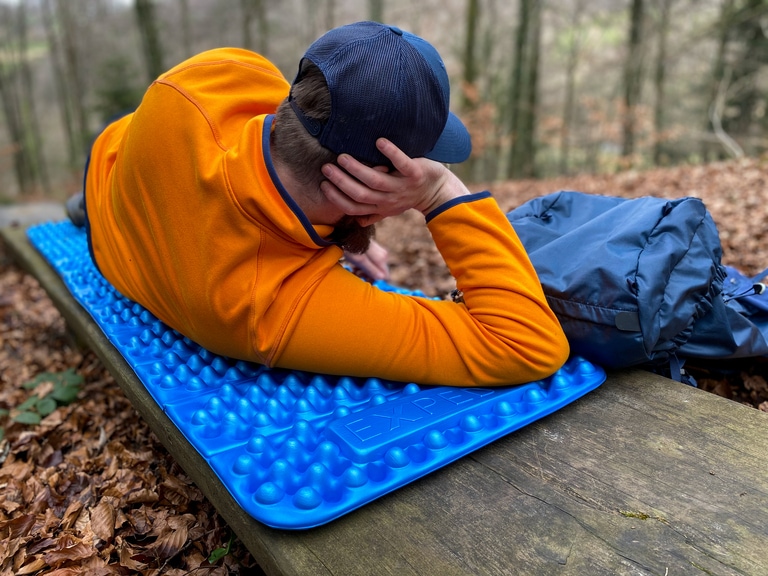
Methodology
Our tester cohort tallied more than 70 nights outside during the spring and early summer of 2024. They slept in the sand in Utah, huddled during torrential thunderstorms in Minnesota and braced against wet snow in Washington.
At the end of our field test, we asked our sleepers to rate each pad on its weight, warmth, comfort, durability and packability. We tallied up the scores, found the averages and presented the best of the best to you in this guide.
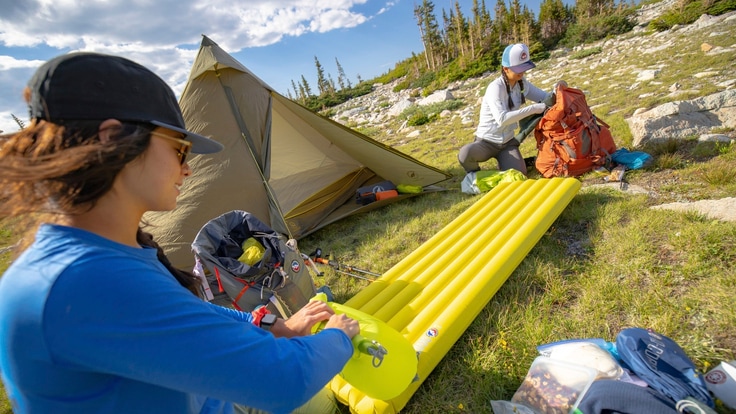

![Trailmade Self-Inflating Sleeping Pad [3/4 view (Fresh Fig)]](/media/9214bf74-413f-4d02-88a1-ba48d2cce70b/?size=440)
![Trailmade Self-Inflating Sleeping Pad [Air valve (Fresh Fig)]](/media/8d4ca631-5231-4054-ae58-19bdd2477b83/?size=440)
![Trailmade Self-Inflating Sleeping Pad [Air valve (Fresh Fig)]](/media/4feae8d3-2b2e-4dd1-9201-55c043a0d583/?size=440)
![Trailmade Self-Inflating Sleeping Pad [Stuff sack (32oz bottle not included) (Fresh Fig)]](/media/bd4a1409-937a-49d0-ae24-2bb725bd07ea/?size=440)

![Divide Insulated Sleeping Pad [3/4 view (Yellow)]](/media/c1a50245-d7e7-4ed6-b757-621c2f172d86/?size=440)
![Divide Insulated Sleeping Pad [Air valve (Yellow)]](/media/f622c2eb-87f9-4ee4-bd5a-905998a1dbfb/?size=440)
![Camp Self-Inflating Sleeping Pad [Regular (Green)]](/media/fdf418f0-b1d7-4116-8218-7f6f7753122d/?size=440)
![Camp Self-Inflating Sleeping Pad [Large (Green)]](/media/67742084-0b12-4412-88f4-50d9e2dd5bcc/?size=440)


![Switchback Sleeping Pad [Back view]](/media/7d92311b-4a86-4157-9411-910781332849/?size=440)

